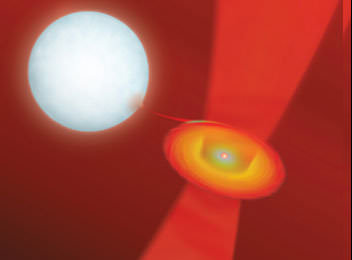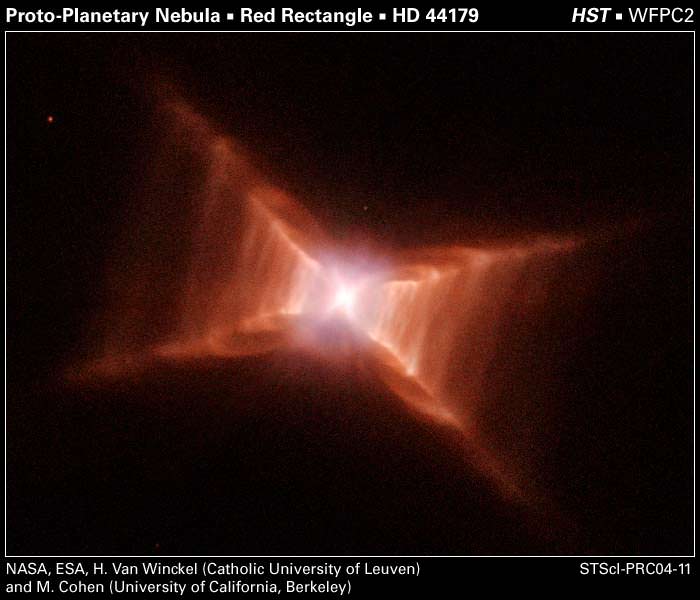[/caption]
Dust is everywhere in space, but the pervasive stuff is one thing astronomers know little about. Cosmic dust is also elusive, as it lasts only about 10,000 years, a brief period in the life of a star. “We not only do not know what the stuff is, but we do not know where it is made or how it gets into space,” said Donald York, a professor at the University of Chicago. But now York and a group of collaborators have observed a double-star system, HD 44179, that may be creating a fountain of dust. The discovery has wide-ranging implications, because dust is critical to scientific theories about how stars form.
The double star system sits within what astronomers call the Red Rectangle, a nebula full of gas and dust located approximately 2,300 light years from Earth.
One of the double stars is a post-asymptotic giant branch (post-AGB) star, a type of star astronomers regard as a likely source of dust. These stars, unlike the sun, have already burned all the hydrogen in their cores and have collapsed, burning a new fuel, helium.
During the transition between burning hydrogen and helium, which takes place over tens of thousands of years, these stars lose an outer layer of their atmosphere. Dust may form in this cooling layer, which radiation pressure coming from the star’s interior pushes out the dust away from the star, along with a fair amount of gas.
In double-star systems, a disk of material from the post-AGB star may form around the second smaller, more slowly evolving star. “When disks form in astronomy, they often form jets that blow part of the material out of the original system, distributing the material in space,” York explained.

“If a cloud of gas and dust collapses under its own gravity, it immediately gets hotter and starts to evaporate,” York said. Something, possibly dust, must immediately cool the cloud to prevent it from reheating.
The giant star sitting in the Red Rectangle is among those that are far too hot to allow dust condensation within their atmospheres. And yet a giant ring of dusty gas encircles it.
Witt’s team made approximately 15 hours of observations on the double star over a seven-year period with the 3.5-meter telescope at Apache Point Observatory in New Mexico. “Our observations have shown that it is most likely the gravitational or tidal interaction between our Red Rectangle giant star and a close sun-like companion star that causes material to leave the envelope of the giant,” said collaborator Adolph Witt, from the University of Toledo.
Some of this material ends up in a disk of accumulating dust that surrounds that smaller companion star. Gradually, over a period of approximately 500 years, the material spirals into the smaller star.
Just before this happens, the smaller star ejects a small fraction of the accumulated matter in opposite directions via two gaseous jets, called “bipolar jets.”
Other quantities of the matter pulled from the envelope of the giant end up in a disk that skirts both stars, where it cools. “The heavy elements like iron, nickel, silicon, calcium and carbon condense out into solid grains, which we see as interstellar dust, once they leave the system,” Witt explained.
Cosmic dust production has eluded telescopic detection because it only lasts for perhaps 10,000 years—a brief period in the lifetime of a star. Astronomers have observed other objects similar to the Red Rectangle in Earth’s neighborhood of the Milky Way. This suggests that the process Witt’s team has observed is quite common when viewed over the lifetime of the galaxy.
“Processes very similar to what we are observing in the Red Rectangle nebula have happened maybe hundreds of millions of times since the formation of the Milky Way,” said Witt, who teamed up with longtime friends at Chicago for the study.
The team had set out to achieve a relatively modest goal: find the Red Rectangle’s source of far-ultraviolet radiation. The Red Rectangle displays several phenomena that require far-ultraviolet radiation as a power source. “The trouble is that the very luminous central star in the Red Rectangle is not hot enough to produce the required UV radiation,” Witt said, so he and his colleagues set out to find it.
It turned out neither star in the binary system is the source of the UV radiation, but rather the hot, inner region of the disk swirling around the secondary, which reaches temperatures near 20,000 degrees. Their observations, Witt said, “have been greatly more productive than we could have imagined in our wildest dreams.”
Source: University of Chicago


What in the world is that thing! Unreal. Two great images.
“The heavy elements like iron, nickel, silicon, calcium and carbon condense out into solid grains, which we see as interstellar dust, once they leave the system,”
Are these “grains” micron size? or larger? do they continue to grow as they age? and what have they become at the end of their 10,000 years?
The Red Rectangle is a bipolar nebula located in the southern constellation Monoceros at 06h 20.0m -10 deg 38′.. The central star appear as a 9th magnitude star. The nebula was first discovered by in 1975, and was named the Red Rectangle by Martin Cohen and Mike Merrill in 1978. A period for the central binary is 318 days, whose orbit is highly eccentric (e=0.37) It is a classic unique example of post-AGB (Asymptotic Giant Branch) binary star.,
This is a well-studied object , which was imaged between 17-18 March 1999 by Hubble.
This looks like an electrically charged architecture. The focus on the dust I think is misleading. It looks to me more like there is a strong electrical imbalance between the two stars and bands of highly charged plasma ribbons are showing that stress. Think of two capacitors of greatly different strength and magnitutes influencing each other electirically.
It’s a little bit confusing.
What is it?
(a) Dust _production_ lasts 10,000 years (in the life of the star), and then dust _production_ stops (and part of the dust leaves the star’s system).
(b) The dust _produced_ lasts 10,000 years and then disappears anyhow.
I think, (a) is correct.